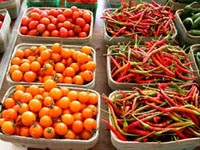
Last year, Mackinnon and Smith wrote an entertaining series of articles in The Tyee about their attempt to live for one year on only food that was produced within 100 miles of their home. The website, which they hope will be a hub for a full-fledged movement of “100-milers,” includes an interactive map where you can chart your personal 100 miles.
Well, the distance of 100 miles must have a ring to it: As reported in Time Magazine today, a group called the Locavores in San Francisco has launched a similar 100-mile effort, though their “eat local” challenges have lasted a mere month. They have 1,000 people signed up from across the US.
Meanwhile, if you’ve been wondering whether you should focus more on buying local or on buying organic you might find some some peace from this Grist excerpt of a new book called Organic, Inc.: Natural Foods and How They Grew. The author argues that local vs. organic is a false choice.
By expanding the organic market, we may be actually helping local farmers. The USDA surveyed farmers’ markets and found that about a third of farmers selling direct were organic—local and organic, that is. In comparison, just 1 percent of all American farms practice organic agriculture. So for smaller-scale farmers selling direct, organic food has become a key component of their identity. By bringing more people into the organic fold, through whatever gateway they happened to choose, the pool of consumers considering local food would likely increase too.
And:
. . . organic food accounts for just 2 percent of food sales—1 percent if you include eating out. Similarly, local foods, though important, total 1 to 2 percent. So arguing over local or organic is a bit like two people in a room of 100 fighting over who has the more righteous alternative to what the other 98 people are doing. It doesn’t really matter, because the bigger issue is swaying the majority.
This approach makes sense to me. Until local and organic food become a larger share of the market the quibbling is a bit beside the point. Why not try for both, when possible?
On the other hand, as this recent Oregonian article points out, the organic food market—though still small—is beginning to grow as fast as a mid-summer zucchini ($14 billion in sales last year). One example is organic giant Earthbound Farms, whose bagged greens are sold in 80 percent of American supermarkets.
Personally, I welcome the “democratization of organic,” as Earthbound’s Myra Goodman calls it. Wal-Mart is probably not going to sell local produce anytime soon, so offering organic in super-stores—as long as adherence to standards can be maintained—is at least a step in the right direction.
In the meantime, I’ll explore the offerings in my own 100-mile foodshed, which gets me from my Seattle community garden plot to somewhere near Wenatchee (apples!) and then from the Canadian border to south of Olympia. It’s a little smaller than I expected—come winter, I might try for the 200-mile diet.
P.S.: More spring reading: Diet for a Dead Planet, a new book by journalist Christoper D. Cook, covers the range of issues: food safety, agribusiness, mad cow, local, organic, subsidies, etc.







hhw
I agree to some extent that the “democratization of organic” is a good thing. However, the increasing involvement of big business has many downsides, for example, the recent reports of dairy farm feedlots used on at least one Horizon farm. (Horizon has been a subsidiary of Dean Foods since 2003.) Mother Jones article; more info from the Organic Consumers Association with a form to send comments to the USDA regarding the loopholes in organic standards that allow such practices – comment period ends 12 June 2006. As for the 100-mile diet, the hardest part for me is the absence of caffeine sources native to Cascadia. I can’t (yet) give up my beloved chocolate and black tea.